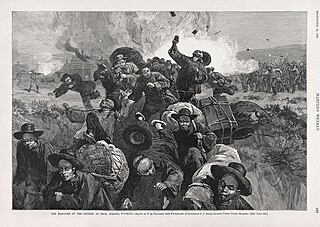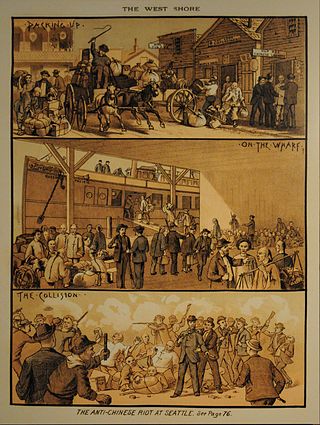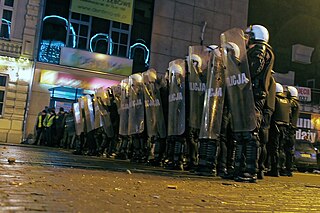Related Research Articles
In the broader context of racism against Black Americans and racism in the United States, mass racial violence in the United States consists of ethnic conflicts and race riots, along with such events as:
The Wheatland hop riot was a violent confrontation during a strike of agricultural workers demanding decent working conditions at the Durst Ranch in Wheatland, California, on August 3, 1913. The riot, which resulted in four deaths and numerous injuries, was subsequently blamed by local authorities, who were controlled by management, upon the Industrial Workers of the World (IWW). The Wheatland hop riot was among the first major farm labor confrontations in California and a harbinger of further such battles in the United States throughout the 20th century.

The 1977 anti-Tamil pogrom in Sri Lanka followed the 1977 general elections in Sri Lanka where the Sri Lankan Tamil nationalistic Tamil United Liberation Front won a plurality of minority Sri Lankan Tamil votes in which it stood for secession. An official government estimate put the death toll at 125, whereas other sources estimate that around 300 Tamils were killed by Sinhalese mobs. Human rights groups, such as the UTHR-J, accused the newly elected UNP-led government of orchestrating the violence. The majority of victims were Tamils.

The Rock Springs massacre, also known as the Rock Springs riot, occurred on September 2, 1885, in the present-day United States city of Rock Springs in Sweetwater County, Wyoming. The riot, and resulting massacre of immigrant Chinese miners by white immigrant miners, was the result of racial prejudice toward the Chinese miners, who were perceived to be taking jobs from the white miners. The Union Pacific Coal Department found it economically beneficial to give preference in hiring to Chinese miners, who were willing to work for lower wages than their white counterparts, angering the white miners. When the rioting ended, at least 28 Chinese miners were dead and 15 were injured. Rioters burned 78 Chinese homes, resulting in approximately $150,000 in property damage.
The Tacoma riot of 1885, also known as the 1885 Chinese expulsion from Tacoma, involved the forceful expulsion of the Chinese population from Tacoma, Washington Territory, on November 3, 1885. City leaders had earlier proposed a November 1 deadline for the Chinese population to leave the city. On November 3, 1885, a mob that consisted of prominent businessmen, police, and political leaders descended on the Chinese community. The mob marched Chinese residents to a railroad station and forced them to board a train to Portland. In the following days, the structures that remained in the Chinese community were razed. The event was the result of growing anti-Chinese sentiment and violence throughout the American West.

The Seattle riot of 1886 occurred on February 6–9, 1886, in Seattle, Washington, amidst rising anti-Chinese sentiment caused by intense labor competition and in the context of an ongoing struggle between labor and capital in the Western United States. The dispute arose when a mob affiliated with a local Knights of Labor chapter formed small committees to carry out a forcible expulsion of all Chinese from the city. Violence erupted between the Knights of Labor rioters and federal troops ordered in by President Grover Cleveland. The incident resulted in the removal of over 200 Chinese civilians from Seattle and left two militia men and three rioters seriously injured.
There were at least several incidents of anti-Chinese violence in Washington, a United States territory and later, a U.S. state, which occurred during the 19th, 20th and 21st century. In the 19th century, the Chinese Exclusion Act of 1882 created hostile attitudes towards the Chinese people residing in the U.S. The act sparked a wave of anti-Chinese riots and murders occurring in Washington, such as the Tacoma Riot of 1885, the Rock Springs massacre and the Hells Canyon massacre in 1887. There were riots and mob actions in Issaquah and Seattle which resulted in at least four people being killed and extensive property damage. Anti-Chinese violence continued throughout the 20th and 21st centuries, particularly in the wake of the COVID-19 pandemic.
The Greek Town riot was a race riot that took place in South Omaha, Nebraska, on February 21, 1909, during which several Greeks were wounded or injured. A mob of 3,000 men displaced some of the population of Greek Town, wrecked 30 buildings there, and started a riot.

The Memphis massacre of 1866 was a series of violent events that occurred from May 1 to 3, 1866 in Memphis, Tennessee. The racial violence was ignited by political and social racism following the American Civil War, in the early stages of Reconstruction. After a shooting altercation between white policemen and black veterans recently mustered out of the Union Army, mobs of white residents and policemen rampaged through black neighborhoods and the houses of freedmen, attacking and killing black soldiers and civilians and committing many acts of robbery and arson.

The Orange Riots took place in Manhattan, New York City, in 1870 and 1871, and they involved violent conflict between Irish Protestants who were members of the Orange Order and hence called "Orangemen", and Irish Catholics, along with the New York City Police Department and the New York State National Guard. The riot caused the deaths of over 60 civilians – mostly Irish laborers – and three guardsmen.
Industrial violence refers to acts of violence which occur within the context of industrial relations. These disputes can involve employers and employees, unions, employer organisations and the state. There is not a singular theory which can explain the conditions under which industrial conflicts become violent. However, there are a variety of partial explanations provided by theoretical frameworks on collective violence, social conflict and labor protest and militancy.

The San Francisco riot of 1877 was a three-day pogrom waged against Chinese immigrants in San Francisco, California by the city's majority white population from the evening of July 23 through the night of July 25, 1877. The ethnic violence which swept Chinatown resulted in four deaths and the destruction of more than $100,000 worth of property belonging to the city's Chinese immigrant population.
The 2000 UEFA Cup Final Riots, also known as the Battle of Copenhagen, were a series of riots in City Hall Square, Copenhagen, Denmark between fans of English football team Arsenal and Turkish team Galatasaray around the 2000 UEFA Cup Final on 17 May 2000. Four people were stabbed in the scuffles, which also involved fans from other clubs and were viewed by the media as part of a retaliation for the killing of two Leeds United fans by Galatasaray supporters the month before.
The Pacific Coast race riots were a series of riots which occurred in the United States and Canada in 1907. The violent riots resulted from growing anti-Asian sentiment among White populations during the late 19th and early 20th centuries. Rioting occurred in San Francisco, Bellingham, and Vancouver. Anti-Asian rioters in Bellingham focused mainly on several-hundred Sikh workers recently immigrated from India. Chinese immigrants were attacked in Vancouver and Japanese workers were mainly targeted in San Francisco.
The Coal miners' strike of 1873, was a strike against wage cuts in the Mahoning, Shenango, and TuscarawasValleys of northeastern Ohio and northwestern Pennsylvania. In the Tuscarawas Valley, the labor action lasted six months, and in the Mahoning Valley four and a half months, but the walkouts failed. The introduction of imported strikebreakers and manufacturers finding substitutes for the area's special block-coal, forced the organized miners back to work at prevailing wages.
Anti-Chinese violence in California includes a number of massacres, riots, expulsions and other violent actions that were directed at Chinese American communities in the 19th century. The attacks on Chinese were often sparked by labor disputes. In the 1880s alone, Chinese communities were attacked in 34 towns in California, often resulting in the local Chinatown being looted and burned.
The Yakima Valley riots were an expression of anti-Filipino sentiment that took place in the Yakima Valley of Washington (state) from November 8–11 in 1927. This riot took the homes and jobs lives of many Filipinos in the area. Unable to receive help or protection from the white police, Filipinos were easy targets for radicalized and angered whites who saw them as thieves of their women and jobs. Under the cover or darkness, and occasionally during the daytime, mobs of white men would harass, threaten, and beat innocent Filipinos for no other reason than their presence.

The anti-Muslim Ełk riots occurred on 1 January 2017 in the town of Ełk, Poland, after 21-year-old Daniel Rudnicki stole two Coke bottles from a local kebab eatery and was murdered by the establishment's cook who chased him with a knife. The fatal stabbing sparked riots the next day. Angry young locals chanted anti-foreigner slogans, smashed Prince Kebab's window, and threw rocks, bottles, and at least one firecracker at the restaurant. Police responded using pepper spray and arrested 28 people.
The Spring Valley race riot of 1895 was a violent racial conflict between Eastern and Southern European immigrants and African American coal workers in the mining town of Spring Valley, Illinois. The conflict was in response to the robbery and shooting of Italian miner Barney Rollo, who reported that his assailants were five black men. The assault provoked the town's long-standing social and racial unrest, and many white immigrant workers united against the African American miners. During the investigation into the shooting several black miners were temporarily taken into custody for questioning and many white townspeople began to form a mob, demanding that all blacks be fired and removed from Spring Valley. The mine manager refused, which prompted the white miners to violently riot against both the black miners and their families, forcing them to flee to the nearby town of Princeton.
References
- Riot At Mamaroneck: Collision Between the Irish and Italian Laborers at Grand Park—Several Man Stabbed. Another Account—Four Persons Reported to Have Been Killed, New York Times, August 14, 1870.